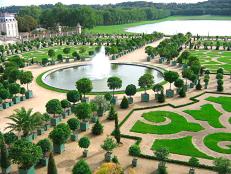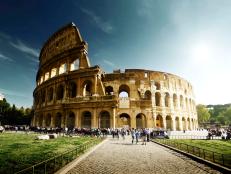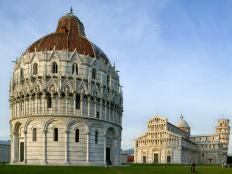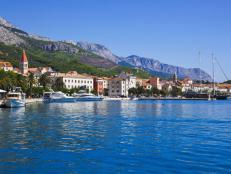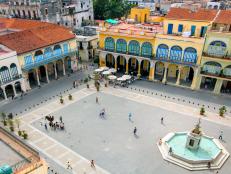Italy's World Heritage Sites
Italy’s World Heritage Sites brim with vibrant wonders. See the haunting city of Pompeii, discover the birthplace of the Renaissance, and tour breathtaking landscapes.
Related To:
lessRelated To:
View The Gallery
1 / 17
Colosseum
Journey to Italy's capital city of Rome for the Roman Empire’s greatest achievement: the Colosseum. The elliptical amphitheater was the largest ever built by the empire, 2,000 years ago.
The Dolomites
Northeastern Italy is home to beautiful mountain ranges. The Dolomites encompass 18 mountain peaks (nearly 11,000 feet at their highest), across 78,000 acres. The area is a popular draw for skiing in the winter, and mountain climbing, hiking and paragliding (among other activities) during warmer months.
Venice and Its Lagoons
A total of 118 islands comprise the city of Venice. Each island is separated by canals and connected by bridges. A lagoon-turned-outdoor-masterpiece, Venice is topped by a diverse architectural style: mainly, Gothic combined with Byzantine and Arab influences.
Piazza del Duomo, Pisa
Look to the right -- that’s the famous Leaning Tower of Pisa. It’s one of four structures in Tuscany heralded as a masterpiece of medieval architecture. Explore each within Piazza del Duomo (“Cathedral Square”), a large, walled area at the center of the Tuscan city of Pisa.
Pompeii, Herculaneum and Torre
The cities of Pompeii, Herculaneum and Torre Annunziata were destroyed when Vesuvius erupted on Aug. 24, 79 A.D. The remains of these cities, which lay buried beneath a thick layer of volcanic ash, stone and mud for nearly 2,000 years, were excavated in mid-1700s -- providing a poignant snapshot of an August day frozen in time. Pictured here are the ruins of the Temple of Apollo in Pompeii.
Basilica of San Francesco d’Assisi
The town of Assisi in central Italy cradles one of the most important places of Christian pilgrimage in Italy: Basilica of San Francesco d’Assisi. Built in the 1200s, the basilica is the mother church of the Franciscan Order.
Valcamonica Rock Drawings
Explore prehistoric art in Italy’s Lombardy region. Drawn over the course of 8,000 years in an era preceding the Iron Age, the prehistoric rock engravings chronicle more than 140,000 figures and symbols, illustrating themes from war to magic.
Amalfi Coast
Not only is the Amalfi Coast an exclusive VIP destination for celebrities like George Clooney, it’s also a natural treasure famed for its natural diversity: from terraced vineyards and orchards to upland pastures.
Su Nuraxi di Barumini
Roughly 2,000 years B.C., a people called the Nuragic civilization lived on the island of Sardinia. Here, they built nuraghi (tower-fortresses). Today, these defensive structures -- of which 7,000 still stand -- represent the most complete example of prehistoric architecture.
Sassi and Rupestrian Churches of Matera
In southern Italy, the region of Matera has been inhabited by humans since the Palaeolithic age. The area’s most impressive feature is “sassi” -- houses carved out of the region’s soft volcanic rocky hills. The area is also famous for its large number of churches, also carved out of the stone.
Historic Center of Florence
The birth of the Renaissance occurred in Florence. Today, the city’s historic center retains this rich cultural heritage, with sites such as Uffizi Gallery (one of the oldest art museums in the Western world) and Pitti Palace (a lavish estate owned by a Florentine banker in the 1400s).
Aquileia Patriarchal Basilica
One of the wealthiest cities of the early Roman Empire was the Northern Italian city of Aquileia -- until it was destroyed by Attila the Hun in the 5th century. Much of this vanquished city still remains unexcavated -- making it one of the richest archaeological troves of its kind. Here’s a look at the Cathedral of Aquileia, a flat-roofed basilica built in 1031 and again, in 1379.
Villa d'Este
Renaissance architecture flourished from the 15th to the early 17th centuries -- and Villa d’Este, in the town of Tivoli, near Rome, is a prime example of it. The villa is surrounded on three sides by a courtyard, and its gardens are enlivened by fountains, pools and water troughs.
Villa Romana del Casale
To view the richest, most extraordinary collection of mosaics from the ancient Roman world, head to southern Italy. Built in the 4th century, Villa Romana del Casale showcases a vibrant collection of images: among them, young women playing sports and hunters with dogs.
Aeolian Islands
It took 260,000 years of volcanic activity for the Aeolian Islands to meld into their present shape. That rich natural history explains why geologists have studied this volcanic archipelago for the past two centuries. Located north of Sicily, the islands are also a popular tourist attraction during the summer.
Santa Maria delle Grazie
Inside the church and Dominican convent of Santa Maria delle Grazie, visitors can see one of the greatest artistic masterpieces of all time: Leonardo da Vinci’s "The Last Supper." The mural was painted between 1495 and 1497, and is located in the refectory of the convent, in Milan.
Botanical Garden, Padua
The world’s oldest botanical garden is located in the northern Italian city of Padua. Created in 1545, Orto Botanico still retains its original layout (a circular central plot), and showcases 6,000 types of plants, from aquatic to alpine varieties.
